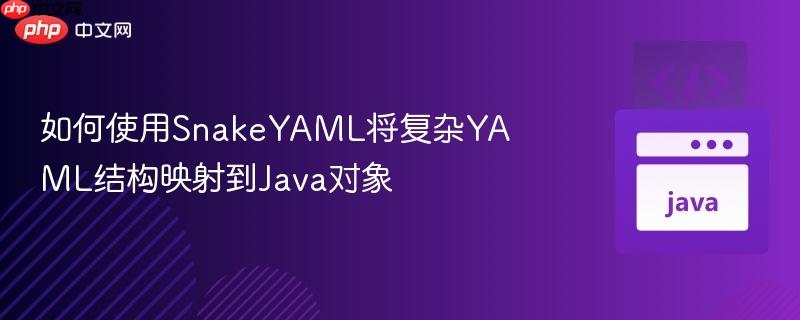
本文旨在指导读者如何利用SnakeYAML库将复杂的YAML文件内容直接映射到强类型的Java对象中,从而避免手动解析嵌套的`LinkedHashMap`和`ArrayList`,实现更简洁、类型安全的数据访问。通过定义与YAML结构对应的POJO类,您可以轻松地加载并操作多层嵌套的数据,如从配置列表中获取特定字段的值。
在Java应用程序中处理YAML配置文件时,常见的做法是使用像SnakeYAML这样的库将其加载到一个通用的Map
为了解决这一问题,SnakeYAML提供了一种更为优雅和类型安全的方法:将YAML内容直接映射到自定义的Java对象(POJO)。这种方法允许我们定义与YAML结构精确对应的Java类,从而在加载时自动完成数据绑定。
假设我们有一个如下所示的YAML配置文件 config.yml:
立即学习“Java免费学习笔记(深入)”;
description: this-apps-config
options:
- customer: joe
id: 1
date: 2022-01-01
print: False
- customer: jane
id: 2
date: 2022-01-02
print: True为了将这个YAML文件映射到Java对象,我们需要创建两个POJO类:一个用于表示顶层结构,另一个用于表示options列表中的每个元素。
首先,定义Customer类来对应options列表中的每个配置项:
import java.util.Date;
public class Customer {
private String customer;
private int id;
private Date date;
private boolean print;
// 必须提供无参构造函数,以及所有字段的getter和setter方法
public Customer() {
}
public String getCustomer() {
return customer;
}
public void setCustomer(String customer) {
this.customer = customer;
}
public int getId() {
return id;
}
public void setId(int id) {
this.id = id;
}
public Date getDate() {
return date;
}
public void setDate(Date date) {
this.date = date;
}
public boolean isPrint() { // 对于boolean类型,getter通常是isXxx
return print;
}
public void setPrint(boolean print) {
this.print = print;
}
@Override
public String toString() {
return "Customer{" +
"customer='" + customer + '\'' +
", id=" + id +
", date=" + date +
", print=" + print +
'}';
}
}接着,定义MyYamlConfig类来表示整个YAML文件的顶层结构:
import java.util.List;
public class MyYamlConfig {
private String description;
private List<Customer> options; // 注意这里是List<Customer>
// 必须提供无参构造函数,以及所有字段的getter和setter方法
public MyYamlConfig() {
}
public String getDescription() {
return description;
}
public void setDescription(String description) {
this.description = description;
}
public List<Customer> getOptions() {
return options;
}
public void setOptions(List<Customer> options) {
this.options = options;
}
@Override
public String toString() {
return "MyYamlConfig{" +
"description='" + description + '\'' +
", options=" + options +
'}';
}
}注意事项:
有了这些POJO类,我们就可以使用SnakeYAML将YAML文件直接加载到MyYamlConfig对象中:
import org.yaml.snakeyaml.Yaml;
import java.io.InputStream;
import java.util.Date; // 确保导入Date类
public class YamlConfigLoader {
public static void main(String[] args) {
Yaml yaml = new Yaml();
try (InputStream inputStream = YamlConfigLoader.class
.getClassLoader()
.getResourceAsStream("config.yml")) { // 确保config.yml在classpath中
if (inputStream == null) {
System.err.println("Error: config.yml not found in classpath.");
return;
}
MyYamlConfig myYamlConfig = yaml.loadAs(inputStream, MyYamlConfig.class);
// 现在可以方便地访问数据了
System.out.println("Description: " + myYamlConfig.getDescription());
System.out.println("Options:");
for (Customer customer : myYamlConfig.getOptions()) {
System.out.println(" Customer Name: " + customer.getCustomer());
System.out.println(" Customer ID: " + customer.getId());
System.out.println(" Print Status: " + customer.isPrint()); // 直接访问print值
System.out.println(" Date: " + customer.getDate());
System.out.println(" ---");
}
// 示例:获取第二个客户的print值
if (myYamlConfig.getOptions() != null && myYamlConfig.getOptions().size() > 1) {
boolean secondCustomerPrint = myYamlConfig.getOptions().get(1).isPrint();
System.out.println("Print status for the second customer: " + secondCustomerPrint);
}
} catch (Exception e) {
e.printStackTrace();
}
}
}在上述代码中:
通过将YAML内容直接映射到自定义Java对象,我们显著提高了代码的可读性、可维护性和类型安全性。这种方法避免了手动处理LinkedHashMap和ArrayList的复杂性,使得从深层嵌套的YAML结构中获取特定数据变得如同访问普通Java对象字段一样简单直观。在处理复杂或频繁变化的YAML配置时,强烈推荐采用这种POJO映射策略。
以上就是如何使用SnakeYAML将复杂YAML结构映射到Java对象的详细内容,更多请关注php中文网其它相关文章!

每个人都需要一台速度更快、更稳定的 PC。随着时间的推移,垃圾文件、旧注册表数据和不必要的后台进程会占用资源并降低性能。幸运的是,许多工具可以让 Windows 保持平稳运行。

Copyright 2014-2025 https://www.php.cn/ All Rights Reserved | php.cn | 湘ICP备2023035733号